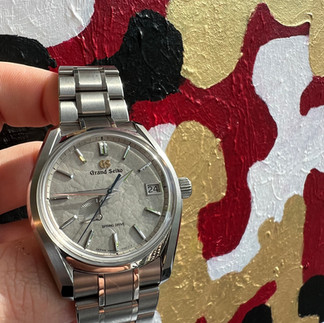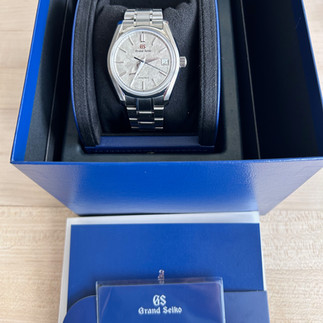In-Depth Review - Grand Seiko Heritage Winter (Taisetsu) - SBGA415
- jarcari
- Sep 15, 2024
- 15 min read
Welcome to Chrono Pursuit where we methodically review the most exciting watches on a 100-point scale so that you can make the best-informed decisions when purchasing your next watch.
Our review process for each watch considers four primary criteria: design, construction, movement and other factors to consider. Each category is broken down into 5 sub-categories, which allows us to precisely quantify what makes a good, great or exceptional watch.
Today, I am reviewing one of my most recent purchases that I actually had my eye on for several years. Since this watch’s debut in mid-2019, I knew that I needed to add it to my collection, but I wanted to purchase it at the source: Japan. The opportunity finally presented itself in late 2023 when I visited my extended family in Japan, and I would be lying if I said I wasn’t buzzing with excitement to purchase this watch at the end of the trip while in Ginza.
The Grand Seiko Heritage Taisetsu (also known as the “winter” version of the Seasons collection by Grand Seiko) is an absolutely stunning watch. In true Grand Seiko fashion, everything about the watch, from the hands to the movement finishing, is simply breathtaking. The quality of craftmanship is unmatched in this price range, largely due to Grand Seiko’s obsession with perfecting a limited catalogue of watches. Due to the exchange rate, discounts and tax-free status, I was able to pick up this up for less than $5,000 - well below the retail price in the U.S. (around $6,600 at the time of writing). Every time I put on this watch, I can’t help but play with the light reflecting over the intricate dial and the hour markers and hands. If perfection was achievable in a watch, this Grand Seiko is as close as I’ve ever seen.

The Taisetsu’s main feature is obviously the textured dial, which is recognized as Grand Seiko’s signature design element. Designed to mimic a Japanese snow-covered mountain landscape, the dial’s texture is simultaneously subtle, yet arresting. Although I have an extensive collection of watches, there is something emotional about this Grand Seiko – the way the light reflects off of the dial is unlike any other watch – and sometimes I catch myself just staring at the dial as the smooth seconds hand glides peacefully across the face like a soft wind across a snow-covered field.
After carefully considering all aspects of this watch, I gave the Grand Seiko Taisetsu an overall score of 87 points out of 100 points, which is incredibly high for the modest price of this watch. Breaking that down further, I scored the design of the watch 21.5 points, 21.5 points for the construction, 23.5 points for the movement and lastly 21 points for various additional factors. For just $6,600 (or even cheaper overseas), you are getting a hand-made watch that you can wear with a t-shirt or a business suit. Beyond the intrinsic value of the watch, every watch collector instantly recognizes a Grand Seiko when it is on your wrist and it is certainly a fantastic conversation starter. To summarize, between the unique spring-drive movement and the even more unique dial, this Grand Seiko is an absolute must-have for any collection.
Overall Score: 87/100
Design – 21.5/25 pts
1. Case (size, shape, construction, angles, finishing) – 4.5/5pts While I typically prefer watches in the 41-44mm range due to my larger wrist size, the Taisetsu’s 40mm diameter case is the perfect size. The watch sports a 12.8mm overall thickness (2mm of which is the boxed sapphire crystal, so the watch actually wears much thinner) and is 46mm lug-to-lug, creating a compact-feeling watch that appears very proportional and balanced. The overall dimensions and textured dial almost make the watch feel “delicate” (like some vintage pie-pan Omegas) - but at the same time the watch feels undeniably solid and made to modern standards. The watch’s lugs flow seamlessly from the case before ending at abrupt, sharp-cut angles which are also polished to create a dramatic sloping effect. The case also features a continuous polished edge on each side of the watch’s bezel that catches light and exhibits Grand Seiko’s skillful Zaratsu polishing capabilities.
2. Dial (color, pattern, indices, hands, chapter ring) – 5/5 pts It’s hard to argue that the Taisetsu’s dial isn’t as close to “perfect” as any watch dial could get. Along with its sibling the “Shunbun” (which has a pink cherry blossom inspired dial and silvered seconds hand), the Taisetsu’s machine-pressed dial resembles a snowy hill in Japan where strong winds have swept unique patterns into the snow. The dial has a surprising number of different textures and colors, ranging from light grays to bluish-black grays. Sitting gracefully over the patterned dial, the hour markers are expertly applied and are diamond-cut with micro-lines on the top surface to catch light while the sides are highly polished and slope towards the gray dial.

The hour and minute hands are classic Grand Seiko sword hands with vertical grain brushed tops and razor-sharp, polished edges that look like they could cut right through your hand if the sapphire crystal wasn’t there for protection. The blued-steel seconds hand also adds a fantastic “pop” of color against the stark background and gray titanium case. The raised black printing of the name and chapter ring is also impeccable and the floating gold “GS” logo casts the slightest shadow over the gray landscape of the dial.
Lastly, the power-reserve indicator – one of my favorite features of the watch – is seamlessly integrated into the complex dial. The sub-dial boasts different finishing techniques, including a concentric grain and a chiseled register showing the increasing power level, and includes two perfectly-polished end elements and a polished indicator hands that blends seamlessly with the rest of the dial’s aesthetic.
3. Strap/bracelet (material, comfort, finishing, clasp) – 4/5 pts As any collector will tell you, the Achilles’ heel of Grand Seiko (and Seiko generally) is its bracelet. The bracelet is made out of the same hardened Grade 5 titanium as the case and sports brushed links with polished center links and an engraved clasp with Grand Seiko’s logo. Overall, the execution is sufficient, but it doesn’t exceed one’s expectations as the rest of the watch does. Perhaps that is our fault, though, as the rest of the watch far exceeds any expectations for a ~$6,000 watch and the bracelet is just “average” for the price point in that context. In reality, would I pay an extra $1,000 for a nicer bracelet? Probably not. Do I think any bracelet at any price point would be able to live up to the same expectations as the rest of the watch? Probably not as well.
4. Bezel (indices, rotation action, scale) – 3.5/5pts The lack of a bezel on this watch puts it in rare company in my collection as most are sports watches with some sort of bezel. However, I really enjoy the Taisetsu’s design, which stretches a boxed sapphire crystal from nearly the edge of the entire watch, creating a “portal” to view the textured dial from multiple angles. The boxed crystal also allows the wearer to view the dial from the extreme edge of the case and provides an unobstructed and unadulterated view of the dial.
5. Originality (design cues, homage, re-issue, re-design) – 4.5/5 pts While Grand Seiko may not have the same timeless history as some other storied watchmakers (some of which are older than several countries), Grand Seiko still has historical pieces to inspire its current offerings. The Taisetsu is mainly inspired by the “62GS” case which was originally released in 1967 as Grand Seiko’s first automatic watch. Fast-forward to the Grand Seiko I’m holding in my hands today, and you can see several design cues pulled directly from the 62GS’s design including the angles of the case and lugs, the razor-edge hands, the lion logo on the exhibition case back, the type-font used on the dial and the diamond-cut hour indices. The Taisetsu builds on the legacy of the 62GS even further by incorporating Grand Seiko’s modern (and un-matched) Spring Drive movement, power reserve indicator and textured dial.
Construction – 21.5/25 pts
1. Overall Quality (case, dial, hands, finishing) – 5/5 pts There is no denying that Grand Seiko’s brand image is synonymous with “quality”. Ask any serious collector and they will gush about Grand Seiko’s quality control, attention to detail and flawless execution. Even under a 10x loupe, I could not find a single flaw on the dial or any indices. Every polished surface is evenly applied (including the sides of the case which exhibit Grand Seiko’s Zaratsu polishing – an art form in itself) and the attention to detail even extends to the polishing and decorations of the movement. As cliché as it might sound, even the wrapping paper and presentation of the receipt at the store in Japan was absolutely flawless and choreographed, leaving me wondering why buying watches isn’t always this impressive?
2. Materials (type of metal, rare metals, finishing technique) – 4.5/5 pts The entire watch (including the bracelet) is constructed from hardened Grade 5 titanium, which Grand Seiko states is one of the most scratch-resistant materials they can produce. I’m always impressed when a watchmaker can make a titanium watch not appear “industrial” – all-titanium watches usually are equated automatically with tool-like peers such as the Tudor Pelagos. Of course, Grand Seiko’s mastery of polishing and finishing (including Zaratsu polishing on the sides of the case) makes it very difficult to write the Taisetsu off as an industrial watch. Additionally, the gray color of the Grade 5 titanium blends seamlessly with the 50 shades of gray of the textured dial (I couldn’t help myself), creating a muted, yet sophisticated, overall complexion of the watch.
3. Resistances (water, magnetism, shock) – 4.5/5pts With a screw-down crown and solid titanium construction the Taisetsu boasts 100m of water resistance, which is plenty for an everyday watch. Powered by Grand Seiko’s proprietary 9R65 Spring Drive movement, this watch also boasts two impressive resistances that other movements with traditional escapements simply can’t match. First, because the Spring Drive does not have a traditional escapement, it is highly anti-magnetic and keeps accurate time without distortion from external magnetic effects. Further, the unique architecture of the gear train (and the lack of a traditional escapement) also make the watch highly resistant to bumps and shocks. For a watch brand best known for its attention to detail and artistic dials, the Taisetsu’s internal specs are nothing short of impressive, which we will get into later on in the review.
4. Ancillaries (lugs, crown, pushers and other extremities) – 3.5/5 pts The entire watch is made out of uniformly gray titanium which extends from the barely-there bezel all the way through the lugs and down to the bracelet. The crown is nicely proportionate to the rest of the watch and allows for easy manipulation but does not uncomfortably jut into the wearer’s wrist. The lugs are also nicely curved until they end at sharp, sloped angles – however, even with the sharp, polished edges the gentle curvature of the overall case and lug design translates into a comfortable all-day wearability.

5. Bracelet/clasp (link type, integration with case, clasp mechanism) – 4/5 pts The integrated bracelet clasp and its mechanism are, for all purposes, acceptable. The single-action clasp feels secure, but lacks the versatility of other double-butterfly clasps. Further, without the quick micro-adjustment capabilities that are becoming more common in this price range, the bracelet does not compare well compared to other competitors in this price range that other brands in this price point. The bracelet itself is well integrated into the case and the polished links flow well with the polished bevels of the case, but some users have reported a “loose” connection between the case and bracelet that can make the watch feel cheap.
Movement – 23.5/25 pts
1. Origin of Movement (Swiss, sourced, in-house, design) – 5/5pts I could spend the entire 30 minute review talking about Grand Seiko’s Spring Drive movement - this movement turns everything you know about watch movements and completely re-writes history. The Spring Drive was born out of Seiko’s obsession for accuracy, which other commentators have discussed extensively (see here and here), so I won’t go into the history too far. After the quartz revolution in Japan (which sent the rest of the watch world into chaos for about several decades), Grand Seiko’s engineers searched for a way to combine the accuracy of quartz with the efficiency of self-winding automatic movements. What they developed over the course of four decades was the Spring Drive movement, which stores energy via a mainspring barrel like a regular automatic but then distributes that power through a gear train called the “tri-sychron regulator” which uses a quartz crystal and glide wheel mechanism to convert that energy into readable time. If you have the time, you should read more about the Spring Drive in the articles I linked above - the Spring Drive movement is a combined work of art and a feat of engineering.

2. Complication(s) (design, usefulness, integration, operation) – 4.5/5 pts The Taisetsu’s Spring Drive movement is largely a no-frills three-hand design with a simple date function located at the 3 o’clock position. However, the Spring Drive has one additional complication that is both useful and adds to the complicated design and execution of the dial: the power reserve indicator. The indicator is cleverly located in the lower left-hand quadrant of the dial and is decorated with an engraved circular grain and polished indices. The Spring Drive boasts a power reserve of 72 hours, which is plenty to last over a weekend. With the power reserve indicator on the face of the watch (and not hidden on the backside like some other brands), the wearer is instantly able to discern whether the Taisetsu’s mechanism has stopped temporarily.

While not technically a “complication”, the Spring Drive’s smooth sweeping seconds hand must also be mentioned in any review. Because of the unique architecture of the Spring Drive movement, the seconds hand does not “tick” in 8 increments per second like a regular watch – it glides effortlessly over the dial in a smooth, sweeping motion. I’ve caught myself countless times watching the blued steel seconds hand sweep over the snowy landscape of the dial. It’s safe to say that the Spring Drive technology and visual execution of this “complication” is without comparison in the rest of the watch industry.
3. Accuracy (overall +/-, positions, variance) – 5/5 pts One of Grand Seiko’s bestselling points for the Spring Drive movement, specifically the 9R65 in this particular watch, is its accuracy. Because the Spring Drive utilizes a quartz oscillator vibrating at an insane 32,786 Hz (compared to a normal watch with 4 Hz), the Spring Drive is able to maintain a +/- 1 second per day accuracy, and typically less than +/- 10 seconds per month. For context, the Spring Drive is twice as accurate as Rolex’s “superlative chronometer” (and less than half the price) and much more accurate that standard chronometers tested under the COSC or METAS standards. The Grand Seiko’s accuracy is both a feat of engineering and also a testament to the level of quality Grand Seiko demands from its watches.
4. Power Reserve (length, indicator, variance) – 4.5/5 pts With 72 hours of power reserve, you do not have to worry about setting the Grand Seiko Taisestsu down overnight or even over the weekend. And if you forget when you put your watch down, a quick glance at the power reserve indicator on the dial will tell you how much juice is left. In addition, Grand Seiko had to make several innovations to make the Spring Drive’s mechanism transmit power from the traditional mainspring to the quartz oscillator – all while maintaining 72 full hours of power reserve which is comfortably above the industry standard of 42-48 hours.
5. Finishing/Design (decoration, finishing, architecture, rotor) – 4.5/5 pts Grand Seiko’s attention to
detail and excellent finishing techniques aren’t just reserved for the case and dial. The Taisetsu’s 9R65 movement is highly decorated – I dare say it might be the most polished and reflective watch movement in my collection by a long shot. Viewing the movement through the clear caseback (and under that pesky decal which many collectors lament), you can see that Grand Seiko puts time and effort into every aspect of this watch. The movement itself (including the rotor) is decorated with Grand Seiko’s version of Geneva Stripes (or Côtes de Genève), beveled edges and anglage. This level of decoration is typically reserved for haute horology brands, so seeing it decorating a unique hybrid-quartz movement in a watch that costs around $6,000 is impressive to say the least.
Other Factors – 21/25 pts
1. Price (Value) (MSRP, secondary (new), secondary (used), value proposition) – 4.5/5pts The Grand Seiko Taisetsu currently retails in the U.S. for $6,600, reflecting several hikes in the pricing over the past few years. However, if you ever happen to be in Japan, this watch can be picked up much cheaper based on currency rates, 0% tax and discounts available at department stores – I was able to pick up my watch for just under $5,000 brand new from a Grand Seiko boutique, which was an absolute steal for this watch. Every time I put this watch on, I am amazed at its quality, lightness and design. I can’t think of many other watches that have as strong of a value proposition as the Taisetsu with its crisp dial, titanium case and one-of-a-kind Spring Drive movement.
2. Quality Control (Finishing, dial cleanliness, mechanical, known issues) – 5/5 pts Grand Seiko excels in its attention to the smallest details, and that extends to its quality control process that is evident in every Grand Seiko watch produced. Even under a 10x loupe, every single polished curve, edge, bevel and pattern is perfectly uniform. Take for example the razor-sharp hour and minute hands. While other top-end manufacturers will use finishing techniques that create an almost-perfect set of hands, the Taisetsu’s sword-like hands are evenly sharpened to a precise point. The hands are honed and polished by hands and it appears as if either hand could be removed from the watch and used as a scalpel in a pinch. The hour markers also validate Grand Seiko’s finishing expertise – each has microscopic “ridges” on the top edge that reflect dazzling light when the watch is turned in the light.
3. Certifications (COSC, METAS, manufacturer) – 3.5/5 pts The coveted third-party certification process is probably the only area that Grand Seiko as a brand does not excel. While Grand Seiko’s Spring Drive movement is likely more accurate than any purely automatic movement made by GS’s European counterparts, the movements beating inside each Grand Seiko are not tested or evaluated by COSC, METAS or any other Swiss-backed certifier. It is a shame that Grand Seiko does not submit its movements to these independent testers – many watch collectors rely on such certifications to establish a movement’s provenance, accuracy and value.
However, the Spring Drive movement is so accurate, COSC’s chronometer certification (or METAS) would not do the Spring Drive justice. The Spring Drive’s monthly tolerance is just a few seconds more than COSC’s daily tolerance for timing deviation – proving Grand Seiko’s mastery of the quartz-automatic hybrid movement. Even METAS’ requirement of +/- 5 seconds per day would be completely unchallenging for the Spring Drive to meet. While I wouldn’t expect to see “chronometer” embellishing the dial of a Grand Seiko anytime soon, perhaps Grand Seiko could invent their own standards (much like JLC’s 1000 hour Master Control test) that could give purchasers peace of mind that their watch will work flawlessly.
4. Warranty (limitations, extensions, service) – 4/5 pts Each Grand Seiko comes standard with a 5-year warranty, which is more or less the industry standard. Given the watch’s hybrid movement and Grand Seiko’s expert execution of the watch, I would have hoped for a slightly longer warranty period (7 years or longer) to symbolize Grand Seiko’s confidence in their product.
5. Presentation (box, certificates, ancillary items) – 4/5 pts Admittedly, the Grand Seiko’s presentation box is unimpressive, especially compared to other luxury watchmakers in the same price range such as Omega’s lacquered tan wood watch box. However, purchasing a Grand Seiko (especially in Japan) is exactly what you would expect from a prestigious Japanese brand: the presentation, customer service and overall shopping experience is impeccable. The blue presentation box, signed warranty cards and wrapping paper are prepped diligently – even the wrapping paper’s creases are expertly folded with razor-sharp precision. Not only that, but the sales associate will set the watch’s time down to the second to ensure the watch leaves the store as accurate as possible. It is impossible to describe how remarkable it is to purchase one of these watches where they are recognized as the pinnacle of watch design – if you ever find yourself in Japan, find a Grand Seiko boutique immediately.

Additional Thoughts
1. Reputation of the watch manufacturer It’s hard to argue that Grand Seiko is not one of the most respected brands in the watch industry, especially for a brand located outside of Switzerland. While many great brands exist outside of Geneva valley, Swiss branding is typically viewed as a badge of quality and heritage that denotes the intrinsic value of a watch. However, brands like Grand Seiko demonstrate that the Swiss don’t have a monopoly on haute horology.
I think the Taisestu is a perfect example of a non-Swiss watch that out-Swiss’s the Swiss. Its dial is mesmerizing and uses pattern techniques that the Swiss wouldn’t even dare try to replicate. Further, the Spring Drive movement unabashedly combines the best parts of a quartz movement and automatic movement to create an insanely accurate self-winding movement, and Grand Seiko’s attention to detail and flawless quality control puts most other brands to shame.
2. Industry recognition In my opinion, Grand Seiko is finally starting to achieve mainstream awareness of the brand’s potential and quality timepieces. It was not so long ago that most serious collectors would not even consider a watch brand from outside of Switzerland, let alone from a subsidiary of the brand (Seiko Time Corp.) that nearly brought about the destruction of the Swiss watch industry with its invention of the cheap quartz movement in 1969.
Now, Grand Seiko is beginning to be recognized as a refined “older” sibling of the storied Seiko brand which offers a refined line-up of luxury watches that combine technological prowess (via the Spring Drive movement) with unique, timeless designs. No other watch manufacturer boasts textured dials and other design elements that Grand Seiko has perfected over the past several decades. On top of that, Grand Seiko’s obsession with perfect execution of the watch, including every polished surface, further solidifies its place among the majority of other luxury watch manufacturers – but often at a fraction of the cost of those other brands.


































Comments